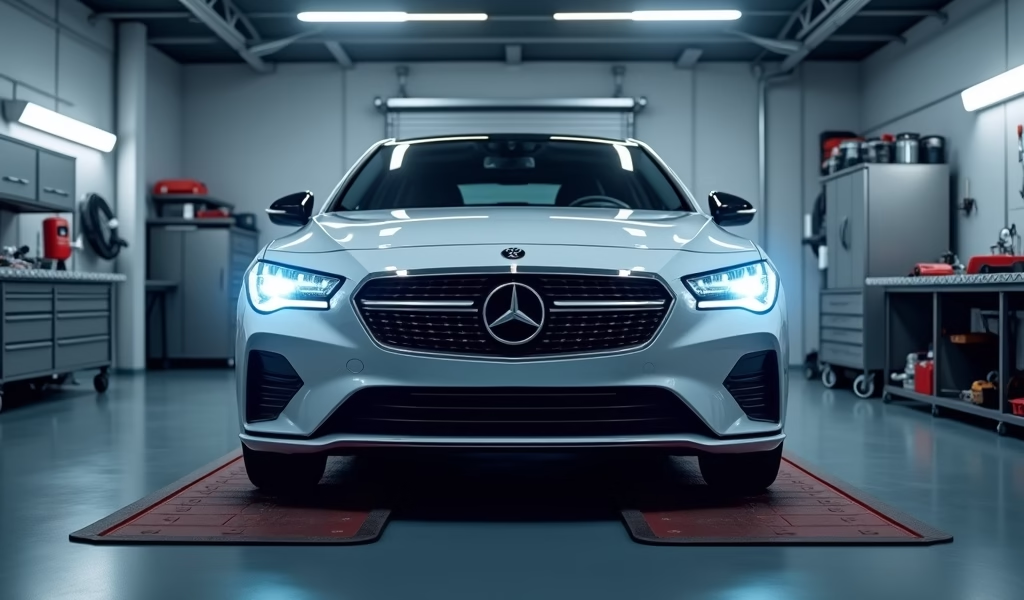Overview
This article provides six practical solutions for fixing headlight leveling system issues, including checking sensors, repairing wiring, proper calibration, addressing control modules, resolving mechanical problems, and resetting after vehicle modifications. Proper headlight leveling is crucial for nighttime driving safety as it ensures optimal road illumination without blinding oncoming traffic, while also helping drivers avoid legal issues from improperly aimed headlights.
Table of Contents
- Understanding Headlight Leveling Systems
- Why Proper Headlight Leveling Matters
- Fix #1: Check and Replace Faulty Level Sensors
- Fix #2: Repair Damaged Wiring Connections
- Fix #3: Properly Calibrate Your System
- Fix #4: Address Control Module Issues
- Fix #5: Resolve Mechanical Adjustment Problems
- Fix #6: Reset After Vehicle Modifications
- When to Call a Professional
- Conclusion
- Frequently Asked Questions
Ever been driving at night only to realize your headlights are illuminating the treetops instead of the road ahead? Or maybe you’ve been temporarily blinded by an oncoming vehicle with poorly aimed headlights. Both situations point to a common automotive issue that’s often overlooked: improper headlight leveling.
As a master technician with over 15 years in the field, I’ve seen countless nighttime visibility problems caused by malfunctioning headlight leveling systems. The good news? Most can be fixed without breaking the bank or requiring advanced technical skills.
In this guide, I’ll walk you through six practical solutions to restore your headlight leveling system to proper working condition. These fixes range from simple adjustments you can make in your driveway to more complex repairs that might require a few basic tools. Let’s shed some light on this important safety feature and get those beams pointing where they belong!
Understanding Headlight Leveling Systems
Before we dive into repairs, let’s get clear on what we’re working with. A headlight leveling system does exactly what the name suggests—it keeps your headlights aimed at the proper height regardless of your vehicle’s load condition.
There are two main types of headlight leveling systems you’ll encounter:
- Manual systems: These feature a simple dial or switch on your dashboard that allows you to adjust headlight aim based on your vehicle’s load. Think of it like adjusting an old TV set—you simply turn the dial until the beam position looks right.
- Automatic systems: These use electronic sensors to detect your vehicle’s position and adjust headlight aim accordingly—all without any input from you. Most modern vehicles with xenon or LED headlights come equipped with these systems as standard.
The basic components typically include level sensors (mounted on the suspension), a control module (the system’s brain), adjustment motors (attached to the headlight assemblies), and the wiring connecting everything. When these components work together properly, your headlights maintain perfect aim whether you’re hauling a trunk full of groceries or driving solo.
Why Proper Headlight Leveling Matters
Let’s be real—proper headlight leveling isn’t just about convenience. It’s a critical safety feature that affects both you and everyone else on the road. When your headlights are aimed too low, your visibility is severely compromised, especially at higher speeds where you need to see farther ahead to react in time.
When aimed too high, your headlights become a dangerous distraction to oncoming traffic. That momentary blindness experienced when facing improperly aimed headlights can lead to serious accidents. In fact, research from the Insurance Institute for Highway Safety shows that improved headlight systems could prevent thousands of crashes annually.
Beyond safety, there’s also the legal aspect. Most jurisdictions have specific requirements for headlight aim, and you could face fines for improperly adjusted headlights during a traffic stop or vehicle inspection. Proper headlight leveling is part of essential car maintenance that keeps you safe and legal on the road.

Fix #1: Check and Replace Faulty Level Sensors
Level sensors are often the first component to fail in a headlight leveling system. Located on your vehicle’s suspension components, these sensors detect the ride height and tell the system when to adjust your headlights.
When sensors go bad, your headlights might stay fixed in one position regardless of load, or they could constantly adjust even on smooth roads. Here’s how to check and replace them:
How to Test Level Sensors
- Locate the sensors on your front and rear suspension (usually attached to the control arms or near the shock absorbers)
- Visually inspect for physical damage, bent sensor arms, or corrosion
- Check that sensor arms move freely without binding
- Using a multimeter, test for proper resistance (typically 1-10 kΩ, though specific values vary by vehicle)
If testing confirms a faulty sensor, replacement is usually straightforward:
- Disconnect your vehicle’s battery
- Unplug the electrical connector from the sensor
- Remove mounting bolts or clips securing the sensor
- Install the new sensor in the same orientation
- Reconnect the electrical connector and battery
- Test the system
A new sensor typically costs between $30-150 depending on your vehicle make and model. It’s a small price for the significant improvement in nighttime visibility and safety.
Fix #2: Repair Damaged Wiring Connections
Electrical gremlins cause countless automotive headaches, and headlight leveling systems are no exception. Over time, wiring can become damaged from road debris, corroded from moisture exposure, or even chewed by rodents seeking a warm place to nest.
Signs of wiring problems include intermittent operation, complete system failure, or erratic headlight movement. Here’s my approach to tracking down and fixing these issues:
Inspecting System Wiring
- Start at the headlight assemblies and follow the wiring harness to the level sensors
- Look for obvious damage like exposed wire, crushed sections, or disconnected plugs
- Check all connectors for corrosion, moisture, or loose pins
- Ensure wires aren’t rubbing against moving parts or hot components
When repairing damaged connections, skip the electrical tape—it’s a temporary fix at best. Instead:
- Use automotive-grade wire of the same gauge for any replacements
- Apply dielectric grease to connections to prevent future corrosion
- Protect repaired sections with heat-shrink tubing
- Secure wires with proper clips to prevent future damage
Taking your time with wiring repairs pays off in the long run. A proper repair will last for years, while hasty fixes often lead to recurring problems that are increasingly difficult to track down.
Fix #3: Properly Calibrate Your System
Sometimes all your system components are functioning correctly, but they’re just out of alignment—like a perfectly good compass that’s pointing south instead of north. Calibration issues often occur after suspension repairs, minor accidents, or significant changes in how you typically load your vehicle.
A proper calibration ensures your headlights illuminate the road without blinding oncoming traffic. Here’s how to get it right:
Calibration Procedure
- Park on level ground facing a wall or garage door (approximately 25 feet away)
- Ensure your vehicle has a normal fuel level and no unusual load
- Measure the height of your headlight centers from the ground
- Mark this height on the wall with tape
- Turn on your low beams
- Adjust your leveling system until the brightest part of the beam is 2-4 inches below your marked line (the exact measurement varies by vehicle manufacturer)
For automatic systems, calibration might require a scan tool that can communicate with your vehicle’s control modules. Some vehicles have specific calibration procedures—check your service manual for details.
Once calibrated correctly, your headlights should provide optimal illumination without creating glare for oncoming traffic. This balance is as important as it is delicate. As part of proper car maintenance, I recommend checking your headlight aim at least once a year or whenever you notice visibility issues.
Fix #4: Address Control Module Issues
Think of the control module as the brain of your headlight leveling system. It processes information from sensors and determines how to position your headlights. Like any electronic component, it can fail or become corrupted over time.
Signs of a problematic control module include erratic headlight movement, system warning lights on your dashboard, or complete failure of automatic adjustments. Here’s how to address these issues:
Diagnosing Module Problems
- Use an OBD-II scanner to check for stored error codes related to the headlight system
- Verify power supply to the module with a multimeter (usually 12V)
- Inspect the module for obvious signs of water damage or corrosion
Before replacing an expensive control module, try these steps:
- Disconnect your vehicle’s battery for 10-15 minutes to reset the system
- Clean the module’s connector pins using electrical contact cleaner
- Check for any software updates that might be available for your vehicle
If these steps don’t resolve the issue, replacement may be necessary. Control modules typically cost between $100-500 and may require programming to your specific vehicle—a task often best left to professionals with the proper diagnostic equipment.

Fix #5: Resolve Mechanical Adjustment Problems
Not all headlight leveling issues are electrical in nature. The mechanical components that physically move your headlights can become stuck, damaged, or worn out over time.
If your headlights seem unresponsive to level changes or make unusual noises during adjustment, you might be dealing with mechanical problems:
Common Mechanical Issues
- Seized adjustment motors
- Broken adjustment gears or screws
- Corroded adjustment mechanisms
- Damaged headlight mounting points
Here’s my approach to fixing these mechanical problems:
- Access the back of the headlight assembly (usually requires removing the headlight or accessing through the engine bay)
- Identify the adjustment motors or screws
- Apply a penetrating lubricant to free up stuck components
- Carefully work the mechanism back and forth to distribute the lubricant
- Replace any visibly damaged parts
For lubricating moving parts, I recommend using a silicone-based lubricant that won’t attract dust or damage plastic components. Apply sparingly—too much lubricant can actually attract dirt and cause future problems.
Mechanical fixes are often among the most satisfying because you can immediately see and feel the improvement in operation. Plus, they tend to be affordable car repairs that provide significant benefits.
Fix #6: Reset After Vehicle Modifications
If you’ve modified your vehicle’s suspension, added heavy accessories, or even switched to a significantly different wheel/tire package, your headlight leveling system may need recalibration. These modifications change the baseline assumptions the system was programmed with at the factory.
Modifications that commonly affect headlight leveling include:
- Suspension lifts or lowering kits
- Heavy aftermarket accessories (winches, steel bumpers, roof racks)
- Significant weight changes (camper conversions, work equipment)
- Different sized wheels and tires
The solution depends on your specific system:
For Manual Systems:
Simply adjust your headlight level control to account for the new baseline ride height. You might need to use a different setting than before for normal, unloaded driving.
For Automatic Systems:
- Use a scan tool to reset adaptation values
- Perform the calibration procedure specific to your vehicle
- In some cases, modify the sensor arm length to compensate for height changes
Many aftermarket suspension companies now include sensor relocation brackets specifically designed to maintain proper headlight leveling function. These brackets adjust the sensor position to compensate for your new ride height, allowing the system to function correctly despite the modifications.
According to SEMA’s lighting compliance guidelines, maintaining proper headlight aim after vehicle modifications isn’t just good practice—it’s essential for legal compliance in most states.
When to Call a Professional
While I’m all for DIY repairs, there are times when calling in a professional makes sense. Consider seeking expert help when:
- Multiple DIY attempts haven’t resolved the issue
- Your vehicle requires specialized programming tools
- The problem is intermittent and difficult to diagnose
- You don’t have access to proper calibration equipment
- Warning lights persist after your repairs
Professional service for headlight leveling systems typically includes comprehensive diagnostics with specialized equipment, access to manufacturer-specific procedures, and proper calibration using professional alignment equipment.
While professional help might cost between $80-300 depending on the complexity of the issue, it’s an investment in both safety and convenience that pays dividends on every nighttime drive. Sometimes, paying for an hour of a skilled technician’s time can save you days of frustration and trial-and-error repairs.
Conclusion
Your headlight leveling system may not be the flashiest part of your vehicle, but its proper function is crucial for nighttime driving safety. Like a lighthouse keeper maintaining their beacon, properly maintaining this system ensures you can see the road ahead while respecting the visibility of oncoming drivers.
The six fixes we’ve covered address the vast majority of headlight leveling problems you’ll encounter. From sensor issues to wiring repairs, calibration to mechanical adjustments, these solutions can restore proper function to your system and improve your driving experience.
Remember that preventative maintenance goes a long way toward avoiding these issues in the first place. Include headlight leveling checks in your regular maintenance routine, address warning lights promptly, and protect wiring harnesses when working on nearby components.
Whether you tackle these fixes yourself or seek professional assistance, properly functioning headlights contribute significantly to your safety on the road. After all, when it comes to nighttime driving, being in the dark should only refer to the time of day—never to what’s happening on the road ahead of you.
Frequently Asked Questions
How do I know if my car has an automatic or manual headlight leveling system?
Check your dashboard for a headlight adjustment dial (indicating manual) or consult your owner’s manual. Most newer vehicles with xenon or LED headlights come with automatic systems as required by regulations.
How often should headlight leveling systems be checked?
Inspect your headlight leveling system at least once a year or whenever you notice poor nighttime visibility. Regular checks are especially important after suspension work or accidents.
Can a failed leveling system damage my headlights?
A failed system won’t typically damage the headlights themselves, but it can lead to improper illumination that compromises safety. Improper aiming can reduce your visibility and blind other drivers.
Do all vehicles have headlight leveling systems?
Not all vehicles have adjustable leveling systems. While most European and Asian vehicles feature some form of headlight leveling, many basic American models may have fixed headlights with manual aim adjustment only.
Will a headlight leveling problem trigger a check engine light?
It typically won’t trigger a check engine light but may illuminate a separate warning light specific to the headlight system. Some vehicles display a message in the instrument cluster instead of a dedicated warning light.

